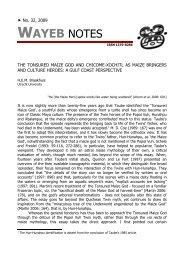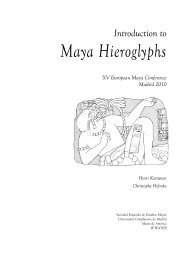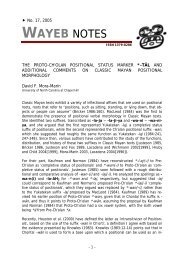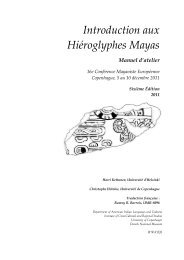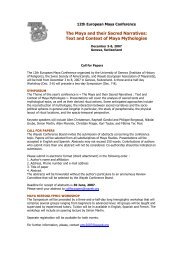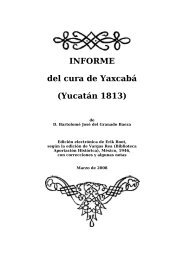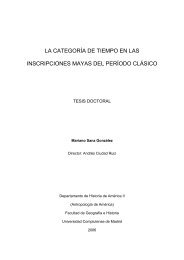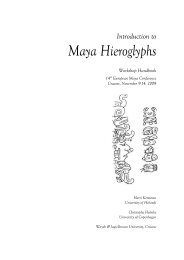Introduction to Maya Hieroglyphs - Wayeb
Introduction to Maya Hieroglyphs - Wayeb
Introduction to Maya Hieroglyphs - Wayeb
Create successful ePaper yourself
Turn your PDF publications into a flip-book with our unique Google optimized e-Paper software.
Kettunen & Helmke 2011<br />
<strong>Introduction</strong><br />
following four glyphs) was still fairly flexible and inconsistent. This carving, along with the Dumbar<strong>to</strong>n Oaks jade<br />
pec<strong>to</strong>ral, represents the events that were <strong>to</strong> be most frequently documented on subsequent <strong>Maya</strong> monuments,<br />
namely bloodletting and royal accession. From the beginning of the Classic Period (ca. AD 250) the <strong>Maya</strong> script<br />
developed in<strong>to</strong> a more consistent and more rigid system that is explained in the following chapters.<br />
3. LANGUAGE(S) OF THE HIEROGLYPHS<br />
Until very recently the study of <strong>Maya</strong> hieroglyphs was a linguistic oddity. Most scholars in the field worked with<br />
their respective languages when translating <strong>Maya</strong> hieroglyphs, and did not realize that the key <strong>to</strong> understanding<br />
<strong>Maya</strong> hieroglyphs is a basic working knowledge of (at least one) <strong>Maya</strong> language. Obviously until the work of<br />
Knorozov and Proskouriakoff 24 , there were few <strong>to</strong>ols <strong>to</strong> work with in the first place. However, most scholars at<br />
the time suffered from a type of scientific myopia, as none tried <strong>to</strong> apply any of the modern <strong>Maya</strong> languages <strong>to</strong><br />
the ancient script. Nowadays it is well established that the languages of the glyphs are very similar <strong>to</strong> several<br />
modern <strong>Maya</strong> languages.<br />
Today there are approximately 30 <strong>Maya</strong> languages spoken in Southern Mexico, Yucatan, Belize, Guatemala, and<br />
Honduras constituting a population of approximately six million speakers. These languages are vaguely<br />
distinguished between the highland and lowland <strong>Maya</strong> languages. Most likely the highland <strong>Maya</strong> languages, or<br />
linguistic subgroups, i.e. Q’anjobalan, Q’eqchi’an, Mamean, K’iche’an, and Tojolabalan, had little or nothing <strong>to</strong> do<br />
with the hieroglyphic texts that have preserved <strong>to</strong> this day. On the other hand, the lowland subgroups, Ch’olan,<br />
Tzeltalan, and Yukatekan, are more intimately related <strong>to</strong> the ancient script.<br />
Nowadays there is substantial evidence that nearly all of the <strong>Maya</strong> hieroglyphic texts were written in an Eastern<br />
Ch’olan language, which has been labeled as “Classic <strong>Maya</strong>”, “Classic <strong>Maya</strong>n” or “Classic Ch’olti’an” (Hous<strong>to</strong>n,<br />
Robertson, and Stuart 2000) by the linguists. The closest modern relative of this language is Ch’orti’, which is<br />
spoken in a relatively small area in Eastern Guatemala and Western Honduras (near the ruins of Copan). Besides<br />
the Classic <strong>Maya</strong> language there is some evidence of the influence of other lowland languages in the <strong>Maya</strong><br />
hieroglyphic corpus: Tzeltalan in a few texts at Tonina, Yukatekan at various sites in the northern part of the<br />
Yucatan peninsula, and isolated Nahua words that appear in various texts 25 . Moreover, evidence of the influence<br />
of Highland <strong>Maya</strong> language(s) in Chama and Nebaj style ceramics has recently been asserted by a number of<br />
scholars (see Beliaev 2005).<br />
24<br />
Proskouriakoff herself never accepted Knorozov’s phonetic approach but, on the other hand, she established the structural methodology <strong>to</strong> the<br />
study of <strong>Maya</strong> glyphs still used <strong>to</strong>day. This structural approach requires no assumption about the character of the language under investigation.<br />
25<br />
Lacadena and Wichmann 2000, 2002b and Alfonso Lacadena, personal communication 2010.<br />
13/154



